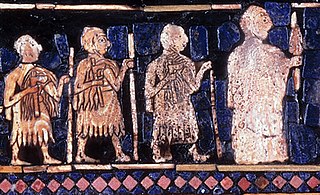 W
WA-Imdugud, was an early ruler of the First Dynasty of Ur in the 26th century BCE. He does not appear in the Sumerian King List, but is known from an inscribed seal found in tomb PG 1236 in the Royal Cemetery at Ur, which is the largest and probably the earliest tomb structure at the cemetery.
 W
WA'annepada was a king of the First Dynasty of Ur, circa 2600 BCE. He was a son of Mesannepada. It is thought that his tomb may be tomb PG 580 in the Royal Cemetery at Ur.
 W
WAkalamdug was an early ruler of the First Dynasty of Ur in the 26th century BCE. He does not appear in the Sumerian King List, but is known from his tomb and an inscription at the Royal Cemetery at Ur. He may have been the father of Meskalamdug, as suggested by the similarity of their names and the chronological proximity of their graves. Alternatively, he may have been the son of Meskalamdug, and therefore brother of the great ruler Mesannepada.
 W
WBalulu was the final king of the First Dynasty of Ur, according to the Sumerian King List, which states he ruled for 36 years:"... Mesh-ki-ang-Nanna, son of Mesannepada, was king, 36 years he ruled; Elulu, 25 years he ruled; Balulu, 36 years he ruled; 4 kings, the years: 171(?) they ruled. Ur with weapons was struck down; the kingship to Awan was carried off.
 W
WElulu is listed as the third king of the First Dynasty of Ur on the Sumerian king list, which states he reigned for 25 years.
 W
WMesannepada, Mesh-Ane-pada or Mes-Anne-pada was the first king listed for the First Dynasty of Ur on the Sumerian king list. He is listed to have ruled for 80 years, having overthrown Lugal-kitun of Uruk: "Then Unug (Uruk) was defeated and the kingship was taken to Urim (Ur)". In one of his seals, found in the Royal Cemetery at Ur, he is also described as king of Kish.
 W
WMeskalamdug was an early Sumerian ruler of the First Dynasty of Ur in the 26th century BCE. He does not appear in the Sumerian King List, but is known from a royal cylinder seal found in the Royal Cemetery at Ur, a royal bead inscription found in Mari, both mentioning him as King, and possibly his tomb, grave PG 755 at the Royal Cemetery at Ur.
 W
WMeskiagnun, also Mesh-ki-ang-Nanna, was the fourth lugal or king of the First Dynasty of Ur, according to the Sumerian King List, which states he ruled for 36 years.
 W
WNin-kisalsi was a Sumerian ruler of the Mesopotamian city of Adab in the mid-3rd millennium BCE, probably circa 2600 BCE.
 W
WPuabi, also called Shubad or Shudi-Ad due to a misinterpretation by Sir Charles Leonard Woolley, was an important person in the Sumerian city of Ur, during the First Dynasty of Ur. Commonly labeled as a "queen", her status is somewhat in dispute, although several cylinder seals in her tomb, labeled grave PG 800 at the Royal Cemetery at Ur, identify her by the title "nin" or "eresh", a Sumerian word denoting a queen or a priestess. As most women's cylinder seals at the time would include a reference to one's husband, the fact that Puabi's seal does not place her in relation to any king or husband supports the theory that she ruled on her own. It has been suggested that she was the second wife of king Meskalamdug. The fact that Puabi, herself a Semitic Akkadian, was an important figure among Sumerians, indicates a high degree of cultural exchange and influence between the ancient Sumerians and their Semitic neighbors. Although little is known about Puabi's life, the discovery of Puabi's tomb and its death pit reveals important information as well as raises questions about Mesopotamian society and culture.
 W
WUr-Pabilsag was an early ruler of the First Dynasty of Ur in the 26th century BCE. He does not appear in the Sumerian King List, but is known from an inscription fragment found in Ur, bearing the title "Ur-Pabilsag, king of Ur". It has been suggested that his tomb is at the Royal Cemetery at Ur. He may have died around 2550 BCE.